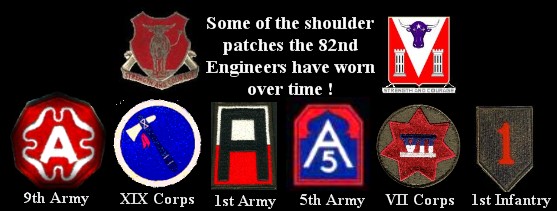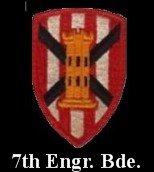|
82nd HISTORY PAGE
Website Best Viewed By 800X600 Pixels On Display Settings


A Short History of the 82nd Engineer Battalion
The Battalion's parent unit was constituted in the Regular Army on 15 July 1940 as the 39th Engineers (General Service).
The Battalion was activated at Camp Bowie, Texas on 8 April 1942 as the 1st Battalion, 39th Engineer Combat Regiment. The
battalion participated in the Louisiana Maneuvers from July – November 1942. On December 27, 1942, the entire regiment
arrived Ft. Dix, New Jersey and later departed the United States on January 13, 1943 from the port of New York bound for North
Africa. The battalion landed at Oran, North Africa in January 1943. Where it continued to train until July 1943 when it received
its baptism under fire.
The Invasion of Sicily
The battalion assaulted the beachs at Gela, Sicily in the early hours of July 7, 1943 with
the 1st Infantry Division in the first assault wave under the command of LTC William O. Darby and his 1st and 4th Ranger Battalions.
After landing on a hostile shore in Sicily, they had repelled several counter-attacks, forced the enemy to withdraw, and relentlessly
pursued him over sun-baked hills until the island was theirs, all in just thirty-eight days. The Sicily Campaign also marked
the first time in World War II that a complete U.S. Field army had fought as a unit. The group went on to serve in Naples-Foggia,
Anzio and Rome-Arno in 1943 and 1944.
Reorganized and Recognized
On 1 March 1945, the 39th Engineer Combat Regiment
was reorganized and re-designated the 39th Engineer Combat Group. The 1st Battalion of the regiment was named the 404th Engineer
Combat Battalion and the 2nd Battalion became the 643rd Engineer Combat Battalion.
The 404th Engineer Battalion supported
operations in the Po Valley Offensive in April 1945. During the attack which ruptured the German winter line at the approaches
to the Po Valley, the battalion operated in support of the 6th South African Division. By the end of the month the newly formed
battalion had played an important role in the spring offensive which destroyed enemy resistance in Italy.
On 2 May, the
39th Engineer Group moved from Vicenza to Bassano, and after one day there, went on to Forasso. By 6 May it was in Trento.
After the Adrige River was crossed, the main effort was opening up the routes of supply in northern Italy. Victory in Europe
Day (VE) was celebrated throughout the battalion on May 9, 1945.
The battalion was awarded the Meritorious Service Unit Plaque for superior performance of duty in the accomplishment of
exceptionally difficult tasks from 1 October 1944 to 1 May 1945 in Italy. The Bronze Arrowhead was awarded to the personnel
of the battalion who had participated in the Gela, Sicily Amphibious Operation. Two additional Battle Participation Awards
in the form of Bronze Service Stars were authorized for participation in the North Apennines and Po Valley campaigns. <BR
With
the end of combat operations in Italy, the battalion was inactivated on 13 October 1945 at Camp Kilmer, New Jersey
Back
Again
On 30 January 1947, the Battalion was re-designated the 82nd Engineer Combat Battalion, then subsequently re-designated
the 82nd Engineer Battalion (Combat)(Army) on 23 November 1954.
On 17 January 1955, the battalion was re-activated at
Fort Leonard Wood, Missouri and deployed to West Germany in October 1961 as
part of the Berlin build up. The battalion was located at Warner Barracks in Bamberg, Germany. The Battalion was assigned
to the 7th Engineer Brigade in support of VII (U.S.) Corps.
Recent History
In May 1985, the 535th Engineer Company (Combat Support Equipment), Grafenwöhr was attached to the
Battalion, giving it a personal strength of over 900 men. On 16 January 1986, the battalion became the first Corps Combat
Engineer Battalion in the VII Corps and only the second in the United States Army to mechanize. The "BLUEBABE" habitually
supported the 2nd Armored Cavalry Regiment (ACR) in its border mission in the defense of Western Europe.
Desert Shield/Desert Storm
The ‘BLUEBABE’ was officially notified of their deployment to Southwest Asia
on 9 November 1990. The Battalion was selected as the first unit in Bamberg to POM and deploy, becoming the first VII Corps
combat unit to deploy and close in SWA under the reinforcing buildup.
Bamberg, Germany
On 15 June 1991, the Battalion was assigned to the 3rd Infantry Division (Mechanized) and on 16
February 1992, the battalion was reorganized as a Divisional Combat Engineer Battalion. In February of 1996, the (Rock of
the Marne) 3rd Infantry Division (Mechanized) re-flagged as The (Big Red One) 1st Infantry Division (Mechanized). The 82nd
Engineer Battalion provides support to the 3rd Brigade Combat Team (BCT) stationed in Vilseck, Germany.
Bosnia-Herzegovina
From March through October 1997, the battalion served in Bosnia-Herzegovina as a part of the
Stabilization Force (SFOR) during peacekeeping operations in the Balkans. The battalion served in Kosovo for six months and
redeployed to Bamberg in June 2000. In November 2002, the battalion deployed again to the Balkans with the 3rd Brigade Combat
Team in support of Operation Joint Guardian KFOR 4B. HHC, A Company and C Company served in Kosovo for six months. The battalion
redeployed to Bamberg in May 2003.
FOR IMMEDIATE RELEASE
March 31, 2006
1ST INFANTRY DIVISION’S 82ND ENGINEERS TAKE ON NEW ROLE AS BATTALION INACTIVATES
By Spc. Joe Alger
BAMBERG, Germany -- Soldiers and family members witnessed the end of an era at Warner Barracks
here with the inactivation of the 82nd Engineer Battalion March 30.
The battalion, which was activated as the 1st Battalion, 39th Engineer Combat Regiment in April 1942, was only
the second combat engineer battalion in the United States Army to mechanize. During their time serving the
Army, the “Blue Babe” participated in World War II, Operation Desert Storm, Bosnia, Kosovo and Operation Iraqi
Freedom before receiving their orders to inactivate. The unit is transforming as it inactivates.
Maj. Joel Quinn, the 82nd Engineers executive officer, said the battalion will officially become
the Special Troops Battalion for the 173rd Airborne Brigade Combat Team in Vicenza, Italy, following its
inactivation. The battalion, Quinn said, will consist of about 30 Soldiers from the 82nd who are either
airborne qualified or have the desire to go to airborne school. The battalion will be made up of four companies:
a Headquarters and Headquarters Company; an engineer company; a military intelligence company, and a signal
company. Quinn said the battalion will “provide combat multipliers for the brigade.” The
transformation has been an ongoing process which began around September of 2005 when the 82nd Engineer Soldiers
began turning in their 4,839 pieces of equipment. Some of that equipment, Quinn said, was
turned in to U.S. Army Europe for them to “rebuild and redistribute” to other units. Other equipment
the 82nd Engineers will need as the Special Troops Battalion was laterally transferred to that unit, and
the remaining equipment was laterally transferred to the 82nd's sister battalion, the 9th Engineer
Battalion, to help prepare them for an upcoming deployment to Iraq. The equipment turn-in was complete in
January. At the same time, many of the battalion's Soldiers were reassigned. Over the past
several months, Soldiers who did not wish to stay with the Special Troops Battalion have been assigned to
other units in USAREUR or throughout the Army. Since returning form Iraq in early 2005, the battalion is
down from around 418 Soldiers to 138.
Lt. Col. Gerald P O’Connor, assumed command of the 82nd just as the unit was preparing for
deployment to Iraq. He said his 26 months as the battalion commander have been very rewarding. “I’m
proud to have had the honor to command a great battalion with a great history,” O’Connor said.
“It’s been very rewarding facing the challenges of having to command in two totally different
environments; first being in Iraq for a year and then coming back and going through the process of turning
in equipment and taking care of Soldiers and helping them with their reassignment process.” While
O’Connor said retiring the colors of the 82nd for the final time was a bittersweet moment, he knows
it is necessary for the advancement of today’s Army. “Watching all the Soldiers leave and casing
the colors is very emotional and sad, but at the same time, it’s necessary to support the transformation
goals of our Army.”
|

